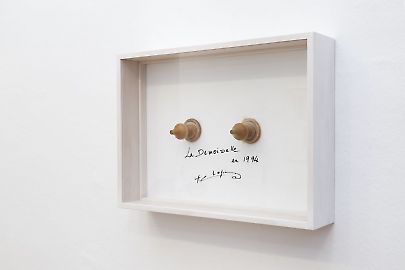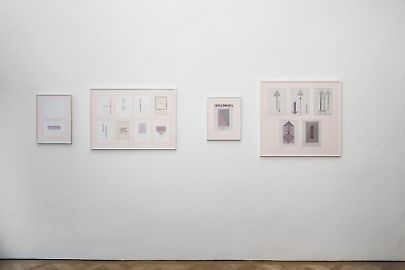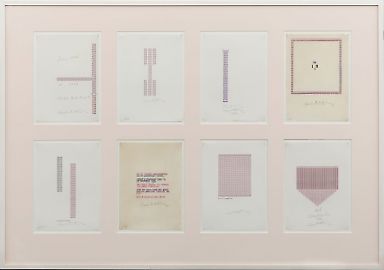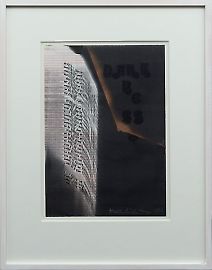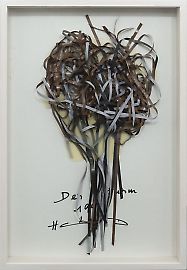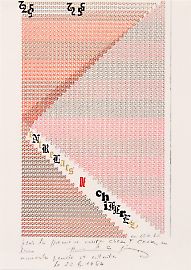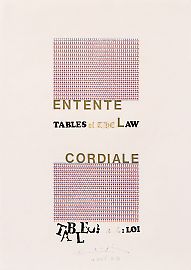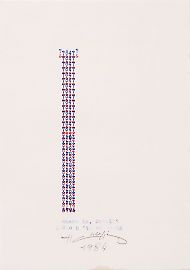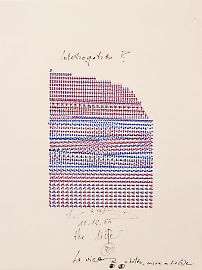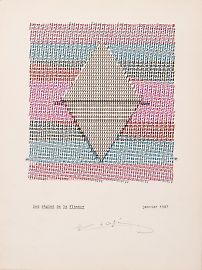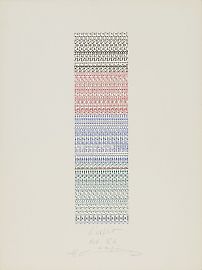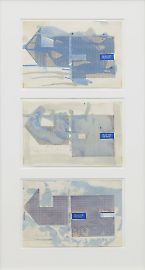Henri Chopin -- Lutte Poétique
Henri Chopin (1922-2008) was a visionary artist, who in his prolific lifespan exhibited, recorded, and circulated widely. A participant in documenta 8, publisher, (OU Review 1964-74) concrete poet, and performer of sound poetry, Chopin was in the vanguard of the literary and artistic milieu of his day. Furthermore, Chopin’s visceral art wasn’t confined to the printed or collaged image and improvisatory performance; in the 1990’s he produced totemic sculptures that incorporated remnants of cut reel-to-reel tapes he used to record and modulate his performances. Set on wooden bases with vertical stems, they’re proxies of the human body and markers of a late stage of his career. Out of the ashes of Dada and Kurt Schwitters’ “Primordial Sonata,” the sound and visual poetry, of which Chopin is a seminal figure, originated in 1950’s Paris and then spread throughout Europe. Its sole aim was to expand the factors of language while transcending writing itself. Chopin himself commented that man’s primal language surpasses all known alphabets, pictograms, and idiographics. Thus in postwar Europe a new language had to be born, not of words, but a language of poetry that foregrounded phonic elements that are usually ignored in daily speech. Its evolution consisted of articulated sounds of words and letters, the noise of breathing, the timbre of a spoken word and the vibrato of the throat.
Chopin the sound artist is a cyclone of force at once unleashed and regulated; the sound is a most peculiar, yet singular utterance radiating from the caverns of his body. These ranging modulated sounds linger in the open air; a lilting wail at one moment, a steamy torrent of combustion at other intervals. Staccato rhythms carry momentum, then, sudden breaks in the recordings flow into transitions with spatial dynamics. A ping here, a low grating hum there, then the briefest of breathing pauses as a silent note before accelerating, then decelerating, and at last fading into the void. In these meaningful sounds and vocal gesticulations you may perceive the shapes and forms of the unseen senses of man. Chopin uses his body as an instrument like a fine-tuned cello or mellifluous violin. All of the stimuli of external and internal sense receptors audibly intimate variation, tone, and color. Temperature, pressure, touch, pain, vision, hearing, taste, and smell are abstractly implied in these etudes of the senses. From the minimalistic to the near symphonic his sound art is structured and contains harmonic equilibrium. At moments they are ephemeral light impressions of a distant time and place, while at other times the recordings’ duration brought Chopin to the limits of his own physical strength. Often compared with Antonin Artaud, he was the volcano and the earthquake that struck his blows in the dark of a dim-lit black box stage. Such powerful audio poems remain benchmarks of the genre.
Underscoring and amplifying Chopin’s achievements with sound art, the visual poems, books, photo documentations of live performances, paintings, and sculptural assemblages form the heart and soul of the exhibition; with their graphic immediacy they show an artist in control of his milieu. The enigmatic notations of the typewritten forms have a formal vocabulary and beauty. Chains of letters link and splinter, the concretized form dominates the page, each letter being a rational miniature structure. The dynamism of these concrete poems was replicated into prints, folios, multiples, posters and exhibition catalogs. They emphasize Chopin’s visual links with Dada, Futurism, and Fluxus, while also declaring his own sensibilities. He had an engaging way of spacing the blocks of letters into architectonic geometries with Palladian symmetry. You can imagine him with the morning coffee and a burning cigarette in hand. Already at work on the typewriting table he churns out a series of works stained and collaged with coffee-press filters and tobacco refuse. Chopin as poète maudit was a survivor of WWII internment camps, prison, and a death march. And, just as his Dadaist predecessors, he came of age during the tumult of war, suffered directly from its cruelty, then came away from it committed to an alternate course through his art. He was one of those autonomous saints of the poet stream that goes on unabated. Apollinaire, Raoul Hausmann, François Dufrêne, E.E. Cummings, William Burroughs, Brion Gysin, Dom Sylvester Houédard, Dieter Roth, and many others can be counted among his brethren. Force unregulated or ill regulated is not only wasted in the void, like that of carbon burned in the open air and steam unconfined by its industrial apparatus. Chopin had the innate ability to regulate this inner force and latent power to summon the velocity of his instrument, the corporeal body. Therein lies the memory of its aches and pains, the knowledge of unspoken horrors, subdued rage, and then a primeval jump beyond the material to elevate it to a transcendental state. Such force was thus corralled into a splendid anima that reached far into the cosmos and landed back on terra firma towards the human sublime.



